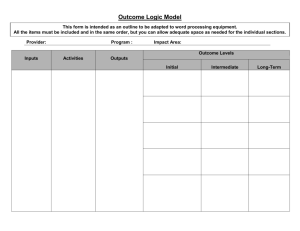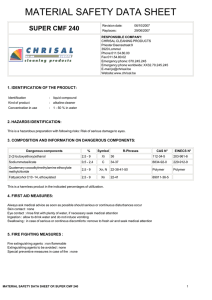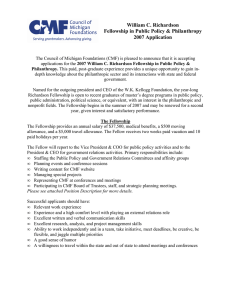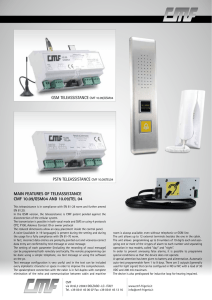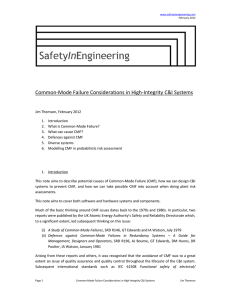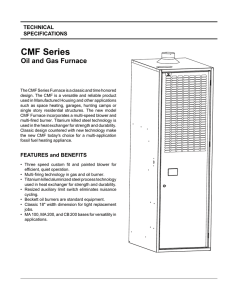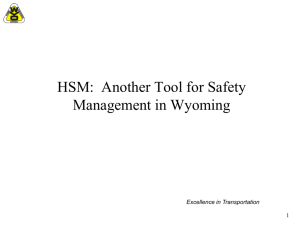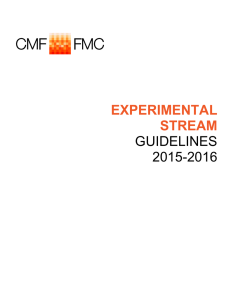here - Community Memorial Foundation
advertisement
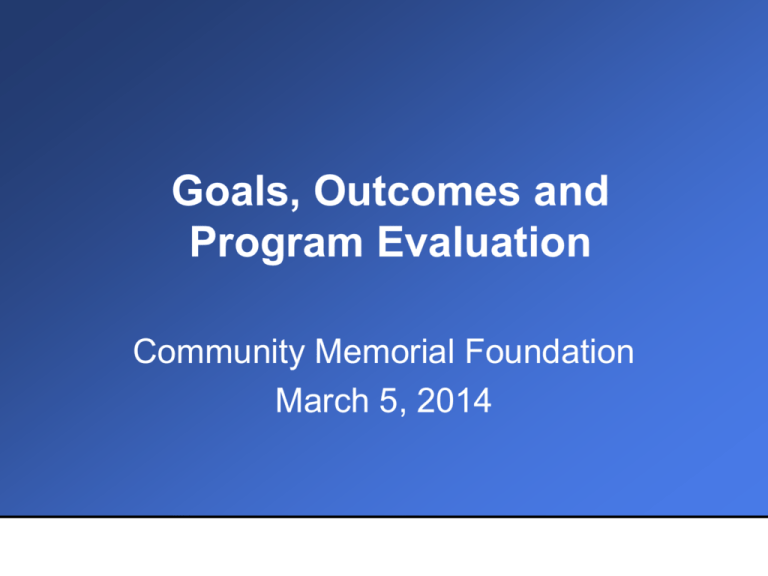
Goals, Outcomes and Program Evaluation Community Memorial Foundation March 5, 2014 Agenda • • • • • Introductions Logic Models Goals, Outcomes, Baselines and Results Implementation and Outcomes Evaluation Q and A Session Objectives • To define terms used in CMF responsive grants application regarding program outcomes and evaluation • To introduce tools and frameworks to facilitate the learning of program evaluation Presenters • Tom Fuechtmann Program Officer, Community Memorial Foundation tfuechtmann@cmfdn.org • Jon Korfmacher, PhD Associate Professor, Erikson Institute jkorfmacher@Erikson.edu Where Program Evaluation is helpful • Understand, verify or increase the impact of services on clients • Improve delivery mechanisms to be more efficient and less costly • Verify that you're doing what you think you're doing • Facilitate management really thinking about what their program is all about, including goals, how it meets goals and knowing if it has met its goals or not. Where Program Evaluation is helpful • Produce data or verify results that can be used for public relations and promoting services in the community. • Produce valid comparisons between programs to decide which should be retained, e.g., in the face of pending budget cuts. • Fully examine and describe effective programs for duplication elsewhere Logic Models A way to summarize how your program works: a “picture” of your program. Note: There is no one “correct” way to develop a logic model * Logic models must be submitted for requests over $25,000 How is a logic model used? • Logic Models have multiple functions: – Program planning – Program management – Evaluation – Communication • Within your agency • With people outside your agency Logic Model Components Inputs (What we invest) Outputs Activities (What we do) Outcomes: Short-term Participants (Who we serve) (Expect) Assumptions: What is necessary for this to happen? Outcomes: Outcomes: Medium Long-term (Want) (Hope) External Factors: What else may impact outcomes? Logic Model Components Inputs (What we invest) • Resources dedicated to or consumed by the project – – – – Staff or volunteer resources Funding Equipment Materials or other resources Logic Model Components Inputs (What we invest) Outputs Activities (What we do) Participants (Who we serve) Ex: 10-week parent training session for teen parents Ex: Teen parents attend at least 7/10 weeks of parent training Logic Model Components Inputs (What we invest) Outputs Activities (What we do) Outcomes: Short-term Participants (Who we serve) (Expect) Outcomes: Outcomes: Medium Long-term (Want) (Hope) • What changes do we expect to see right away? • What changes would we want to see after that? • What changes would we hope to see after that? Ex: College HIV prevention Short Term College students have knowledge of how HIV/AIDS is spread Intermediate College students practice safe sex Long Term Lowered incidences of HIV cases on college campuses Closer in Time More distant in time Easier to Measure Harder to measure More attributable to Project Less attributable to project Congratulations! You now have a logic model! (Now what?) Remember… 1. Logic models are working documents • Responsive programs need evolving models • They can and should be open to change 2. The process is as important as the product 3. Your logic model is only the first step of an evaluation CMF Application Application continued Application continued • Goal: What you hope to achieve with this program (ex. To Reduce Homelessness) • Outcomes: Changes that will occur as a result of your work (short term, intermediate, long term). Ex: 20% of those receiving services will be in permanent housing 6 months after graduating from program. • Baseline: What is the current level of care? Ex. Only 2% are in permanent housing after a period of 6 months. Evaluating Outcomes: What changes have occurred? • Outcomes: the changes you expect to see as a result of your work • Indicators: the specific way you measure an outcome. In other words, “How will I know it?” Outcome Examples Short Term Intermediate What do we Expect to Occur? What do we Want to occur? Seniors increase knowledge of food contamination risks Participants learn jobseeking skills Teen mothers report negative attitudes towards smoking while pregnant Seniors practice safe food handling Long Term What do we Hope will occur? Seniors experience lowered incidence of food borne illness Outcomes: Common types of Indicators • New knowledge • Changed decisions • Increased skills • Modified behavior • Changed attitudes, opinions or values • Changed policies • Changed motivation or aspirations • Changed conditions Ex: HIV/AIDS Prevention Outcome Indicator Intermediate: Students practice safe sex Poor: Number of college students in program over time. Better: Percent students who talk about illness with friends Strong: Percent students reporting regular condom use Long Term: Number HIV/AIDS cases decrease on college campus Evaluating Outcomes: Indicator Statements Elements of a Strong Statement: – How much? – Who? – What ? – When? Evaluating Outcomes: Indicator Statements Example: “ 75% of program participants find parttime employment within six months of enrollment.” But… Have a rationale for the indicator (e.g., why 75%?) Collecting Evaluation Information Questions to Ask Yourself – What resources do you have? – Quantitative or Qualitative? – Standardized or non-standardized? What makes the most sense for your program and the outcome in question? CMF and Evaluation Outcome Objectives and Program Review – What is the impact and how will this move CMF’s mission forward? – What are the chances those results will be achieved? – Given the opportunities before us, is this the best use of the Foundation’s assets? CMF and Evaluation (continued) • Grantees as Partners • Trust • Open Dialogue • A Learning Foundation Questions and Answers Additional Resources • Innovation Network www.innonet.org • Free Management Library www.managementhelp.org/evaluatn/fnl_eval.htm • University of Wisconsin- Extension (Logic Model) http://www1.uwex.edu/ces/lmcourse/.


